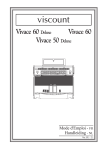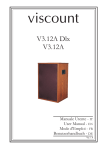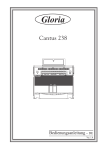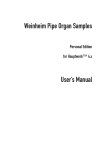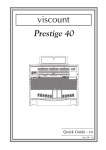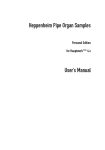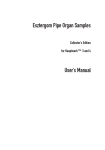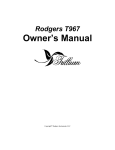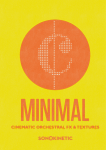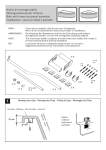Download viscount
Transcript
viscount Vivace 40 Deluxe Vivace 40 Vivace 30 Deluxe Vivace 30 Vivace 20 PEDAL FIELD FIELD EXIT VALUE + VALUE ENTER GENERAL REVERB PEDAL MAN.I Prinzipal Subbass Violon 16' 16' 16' THRU Gedackt 8' Choralbass 4' MAN. I Mixtur Posaune Trompete Klarine 4 f. 16' 8' 4' Coupler I/P Coupler II / P OUT MIDI IN MAN. II Prinzipal Prinzipal Rohrflöte Oktave Spitzflöte Oktave Kornett Mixtur Trompete Trompete 16' 8' 8' 4' 4' 2' 3 f. 4 f. 16' 8' Tremulant Coupler II / I Prinzipal Bourdon Gamba 8' 8' 8' Vox Celeste 8' Rohrflöte Quintflöte Waldflöte Terz Scharf Oboe Clarion 4' 2 2 / 3' 2' 13/5' 3 f. 8' 4' Tremulant viscount POWER S HEADPHONES Oktavbass 8' L(MONO) R INPUT MIDI P MIDI I MIDI II PREV NEXT HR 1 2 3 4 5 6 L(MONO) R OUTPUT A.P ENC Vivace 40 Deluxe T C L(+R) R OUTPUT - 1 MAN. I / PEDAL L(+R) R OUTPUT - 2 MAN. II User Manual - EN Ver. EU - 2.1 Owner’s Manual Viscount Vivace 40 Deluxe - 40 - 30 Deluxe - 30 - 20 INDEX 1. Important notes .................................................................................................................................. 39 1.1 Looking after the product .............................................................................................................. 39 1.2 Notes about the manual ................................................................................................................. 39 2. Controls and connection .................................................................................................................... 41 2.1 The front panel ............................................................................................................................... 41 2.2 The manual splitter controls .......................................................................................................... 42 2.3 Pedal board controls ...................................................................................................................... 44 2.4 The connections underneath the manuals ..................................................................................... 45 3. Main control unit ............................................................................................................................... 47 3.1 Switching on and main video page ............................................................................................... 47 3.2 An introduction to the instrument’s setup functions ..................................................................... 48 4. Organ Style ......................................................................................................................................... 50 5. Replacing voices and regulating voices volumes ............................................................................ 51 5.1 Regulating the voices volumes...................................................................................................... 51 5.2 Replacing voices ............................................................................................................................ 52 5.3 Checking the stop labels ................................................................................................................ 54 6. Temperament ...................................................................................................................................... 55 7. Instrument general settings .............................................................................................................. 56 7.1 Setting the tremulants .................................................................................................................... 57 7.2 Selecting the type of reverb ........................................................................................................... 57 7.3 Equalizers adjustment .................................................................................................................... 59 7.4 Signal routing on the audio outputs .............................................................................................. 60 7.5 Regulating the audio output volumes............................................................................................ 60 7.6 General manual settings ................................................................................................................ 61 7.7 [PREV] and [NEXT] pistons settings ........................................................................................... 62 7.8 Combination saving settings ......................................................................................................... 62 8. MIDI .................................................................................................................................................... 63 8.1 Selecting the channels ................................................................................................................... 65 8.2 Program Change message transmission ........................................................................................ 65 8.3 Setting the filters ............................................................................................................................ 66 9. Utility functions .................................................................................................................................. 67 9.1 Factory Setting ............................................................................................................................... 67 10. Appendix ........................................................................................................................................... 69 10.1 Demonstration songs ................................................................................................................... 69 10.2 Voice Local Off ............................................................................................................................ 69 10.3 Upgrading the operating system.................................................................................................. 70 37 Viscount Vivace 40 Deluxe - 40 - 30 Deluxe - 30 - 20 38 Owner’s Manual Owner’s Manual Viscount Vivace 40 Deluxe - 40 - 30 Deluxe - 30 - 20 1. IMPORTANT NOTES 1.1 LOOKING AFTER THE PRODUCT • Do not apply excessive force to the organ’s structures or the controls (knobs, stops, push-buttons, etc.). • When possible, do not place the instrument close to units which generate strong interference, such as radios, TVs, computer videos, etc. • Do not place the organ close to heat sources, in damp or dusty places or in the vicinity of strong magnetic fields. • Do not expose the instrument to direct sunlight. • Never insert foreign bodies inside the instrument or pour liquids of any kind into it. • For cleaning, use only a soft brush or compressed air; never use detergents, solvents or alcohol. • Always use good quality screened cables for connection to amplification or diffusion systems. When disconnecting cables from sockets, always take hold of the connector and not the cable itself; when winding cables, do not knot or twist them. • Before making the connections ensure that the other units (especially amplification and diffusion systems) you are about to connect are switched off. This will prevent noisy or even dangerous signal peaks. • Connect the net cable to an earthed socket. • Check that the voltage corresponds to the voltage shown on the serial number plate of the organ. • If the organ is to be out of use for lengthy periods, disconnect the plug from the power socket. 1.2 NOTES ABOUT THE MANUAL • Take good care of this manual. • This manual is an integral part of the instrument. The descriptions and illustrations in this publication are not binding. • While the instrument’s essential characteristics remain the same, the manufacturer reserves the right to make any modifications to parts, details or accessories considered appropriate to improve the product or for requirements of a constructional or commercial nature, at any time and without undertaking to update this publication immediately. • All rights reserved; the reproduction of any part of this manual, in any form, without the manufacturer’s specific written permission is forbidden. 39 Viscount Vivace 40 Deluxe - 40 - 30 Deluxe - 30 - 20 Owner’s Manual • All the trademarks referred to in this manual are the property of the respective manufacturers. • Please read all the information carefully, sothat you obtain the best performance and will from your instrument. • The codes or numbers in square brackets ([]) indicate the names of the buttons, sliders, trimmers and connectors on the instrument. For example, [ENTER] refers to the ENTER button. • The illustrations and display pages are purely guideline and may differ from those actually shown on the display. 40 Owner’s Manual Viscount Vivace 40 Deluxe - 40 - 30 Deluxe - 30 - 20 2. CONTROLS AND CONNECTIONS 2.1 THE FRONT PANEL The front panel above the two manuals contains the stops, arranged section by section, used to activate the organ’s registers. Prinzipal Subbass Violon 16' 16' 16' Oktavbass 8' Gedackt 8' 1 2 3 PEDAL MAN. I MAN. II Choralbass 4' Mixtur Posaune Trompete Klarine 4 f. 16' 8' 4' Coupler I/P Coupler II / P Prinzipal Prinzipal Rohrflöte Oktave Spitzflöte Oktave Kornett Mixtur Trompete Trompete 16' 8' 8' 4' 4' 2' 3 f. 4 f. 16' 8' Tremulant Coupler II / I Prinzipal Bourdon Gamba 8' 8' 8' Vox Celeste 8' Rohrflöte Quintflöte Waldflöte Terz Scharf Oboe Clarion 4' 22/3' 2' 13/5' 3 f. 8' 4' Tremulant 1. [PEDAL] section: this section contains the pedal board register stops. The following couplers are also provided: o [I/P]: the stops of the first manual will also play on the pedal board. o [II/P]: the stops of the second manual will also play on the pedal board. 2. [MAN. I] section: contains the stops and tremulant of the first manual and the coupler: o [II/I]: the stops of the second manual will also play on the first manual. 3. [MAN. II] section: second manual stops and tremulant. On the left of the front display panel are located the other organ controls such as volumes, reverb adjustment and display adjustment (only when the adjustment and configuration functions are displayed). 4. Display: alphanumeric display with 20 characters on 4 lines for display of all the screens relating to the organ’s functions. 5. [FIELD ] and [FIELD ] buttons: buttons used to move the cursor around within the display screens. The [FIELD ] button moves the cursor to the field above (the one currently selected) while [FIELD ] selects the field below. 6. [VALUE +] and [VALUE -] buttons: buttons for adjusting parameters. [VALUE +] increases the value, [VALUE -] decreases it. 7. [EXIT] and [ENTER] buttons: buttons for accessing or exiting menu screens. [ENTER] is used to enter the menu or function shown on the display or confirm any prompts from the system. [EXIT] is used to exit the screen on the display and return to the previous one, or abort any prompts from the system. 41 4 FIELD + VALUE FIELD VALUE ENTER 5 7 6 EXIT Viscount Vivace 40 Deluxe - 40 - 30 Deluxe - 30 - 20 Owner’s Manual 8. [GENERAL] trimmer: regulates the organ’s general volume. 8 9 GENERAL REVERB PEDAL MAN.I POWER 10 11 12 9. [REVERB] trimmer: regulates the level of the reverb digital effects. 10. [PEDAL] trimmer: pedal board volume. 11. [MAN. I] trimmer: first manual volume. 12. [POWER ] Switch: the switch used to switch the organ on and off. WARNING! Do not switch the organ on and off in rapid succession. After the instrument is switched off, wait at least 10 seconds before switching it back on. 2.2 THE MANUAL SPLITTER CONTROLS The pistons of the adjustable combinations, Tutti, couplers and other accessory functions are placed in the areas between the manuals. S 1 MIDI P MIDI I 2 MIDI II PREV NEXT 3 HR 1 2 3 4 5 4 6 A.P 5 Vivace 40 Deluxe ENC 6 T C 7 8 1. [S] piston: “Set” (or fix) function used for fixing combinations. To fix a combination, simply press the [S] piston, keep it pressed and then press the combination you wish to fix. 2. [MIDI I], [MIDI II] and [MIDI P] buttons: this section contains the pistons used to activate the transmission of MIDI note codes on the [MIDI OUT] port (in the recess underneath the first manual) in response to the notes played on the manuals. The LED of each piston displays the status of transmission on the relative MIDI channel as follows: o Piston illuminated: note code transmission enabled o Piston off: note code transmission disabled [MIDI I] controls transmission of the notes played on the first manual, [MIDI II] controls the notes played on the second manual, and [MIDI P] the notes played on the pedal board. 42 Owner’s Manual Viscount Vivace 40 Deluxe - 40 - 30 Deluxe - 30 - 20 N.B. - These pistons activate or deactivate the transmission of MIDI note codes (Note On and Note Off) only, unlike all the other MIDI messages the organ is able to process, which are always transmitted regardless of the status of this function. - These pistons control transmission of MIDI notes only. Reception is always enabled. 3. [NEXT] and [PREV.] stops: general combination sequencers. [NEXT] selects combinations in ascending order, [PREV.] in descending order. 4. General combinations: this section contains the instrument’s general adjustable combinations. When a combination is recalled, the light of the relative stop illuminates to confirm its activation. The [NEXT] pistons can also be used to select combinations one by one in an upward direction and [PREV.] for the same function in a downward direction (combination sequencers). There is also a piston marked [HR] (Handle Registers) beside the general combinations; also known as 0, when it is on it automatically memorises the register status. This piston’s main function is to restore, during use of the combinations, the “hand-made” stop setup created when the [HR] button was on. Remember that an HR setup is not modified if the stops are switched on and off by hand when a combination on the same section is selected (i.e. with the HR off). N.B. The contents of the HR are not retained when the organ is switched off. Each combination (including HR and Tutti) is able to store: - the status (on/off) of the stops the status of the couplers the status of the tremulants (even with different modulation depths and speeds, if the specific SET-UP menu function described in par. 7.9 is activated) the style (Organ Style) the MIDI controls (point 2) and the Program Changes set using the SEND PROGRAM CHANGE function (par. 8.2) Enclosed and Automatic Pedal (activating the specific function, see par. 7.9). For the fixing combinations procedure, see point 1. 5. [A.P.] piston: this piston controls the status of the Automatic Pedal function used to play the stops of the pedal board using the first 32 notes of Man.I. In this case, the organ’s pedal board is deactivated and the stops become monophonic, with priority to the lowest note. 6. [ENC] piston: pressing this piston activates the Enclosed function used to control the organ’s general volume using the swell pedal [MAN. II]. 43 Viscount Vivace 40 Deluxe - 40 - 30 Deluxe - 30 - 20 Owner’s Manual N.B. When the Enclosed function is activated, the volumes of the first manual and pedal board are immediately set in relation to the position of the [MAN. II] swell pedal. When the Enclosed function is deactivated, the volumes of the above sections are immediately reset in relation to the position of the [MAN. I / PEDAL] swell pedal. 7. [T] piston: piston used for switching the Tutti on and off. The voice composition of the Tutti function is programmable. To set a new configuration, switch on the stops and couplers of your choice, press [S], keep it pressed and then press the [T] piston. 8. [C] piston: Cancel piston, which switches off all the stops, tremulants, couplers and pistons on any manual divisions active, then resets the HR. 2.3 PEDAL BOARD CONTROLS MAN. I / PEDAL MAN. II 1 2 1. [MAN. I / PEDAL] pedal (not present on Vivace 20): swell pedal used to control the volume of the first manual and pedal board. 2. [MAN. II] pedal: you can use this swell pedal to control the volume of the second manual. N.B. The trimmer volume controls on the left of the manuals allow balancing of the sections; once you have set the levels best suited to your taste and the sound balance you require, they will not require frequent adjustment. The swell pedals, on the other hand, allow continuous control of the volumes, enabling you to obtain all the dynamic effects you wish. Apart from regulating the volume, the swell pedals also simulate the variation in timbre of the stops which would occur in the swell boxes of pipe organs. 44 Owner’s Manual Viscount Vivace 40 Deluxe - 40 - 30 Deluxe - 30 - 20 2.4 THE CONNECTIONS UNDERNEATH THE MANUALS In the left of the organ, under the surface which contains the manuals and side panels, there is a small recess containing various connectors for connecting the organ to remote sound and MIDI devices. 1 HEADPHONES 2 THRU OUT MIDI 3 IN L(MONO) R INPUT 4 L(MONO) R OUTPUT 1. [HEADPHONES] connector: Jack socket to which a headphone set can be connected. With headphones connected, the organ’s internal amplification is cut off. N.B. To obtain the best results from the [HEADPHONES] output, phones with impedance of at least 16Ω should be used. 2. [MIDI] connectors: five-pin DIN connectors for connection of instruments with MIDI interface. The [IN] connector allows receipt of MIDI data generated by remote MIDI sources, the [OUT] connector transmits the MIDI messages generated by the Vivace, and the [THRU] connector transmits the MIDI data exactly as received at the [IN] connector. 3. [INPUT] connectors: RCA line inputs which allow other instruments to be played using the organ’s internal amplification. If the source is monophonic use the L(MONO) connector only. 4. [OUTPUT] connectors: RCA line outputs for the unamplified signal, for connection of optional amplified speakers, remote amplification systems or recording systems. To use a monophonic signal, connect to the [L/(MONO)] connector only. 45 Viscount Vivace 40 Deluxe - 40 - 30 Deluxe - 30 - 20 Owner’s Manual Under the keyboards on the right side you will find the stereo line in and line out sockets. In the bottom of the rear panel there are two more pairs of line audio outputs. The main difference between these outputs and the ones on the left is that the latter contain the signal generated by the organ, while on the right connectors, the signals of the individual manuals and pedal board are routed to and adjusted on the individual outputs in accordance with the relative settings on the display (for more information see points 7.5 and 7.6). L(+R) R OUTPUT - 1 L(+R) R OUTPUT - 2 1 1. [OUTPUT 1] and [OUTPUT 2] connectors: Jack line outputs carrying the organ signal in accordance with the routing set by means of the function on display. With the Factory Settings active, the signals are distributed as follows: - [OUTPUT 1]: General signal [OUTPUT 2]: Reverb only 46 Owner’s Manual Viscount Vivace 40 Deluxe - 40 - 30 Deluxe - 30 - 20 3. MAIN CONTROL UNIT As described in the previous section, the left-hand panel contains the main control unit for all the Vivace’s internal functions. The organ features a large set of control functions allowing the user to customise the instrument in the most suitable way, adapting it to his or her own requirements. These are not mere general settings, but setup functions that configure every part of the organ: for the sound setup, for example, the user can select the instrument’s musical style, or change the registers assigned to the stops and then regulate their individual volumes. The levels, equalisation and channel routing of the remote outputs can also be adjusted. The organ also allows complete, unrestricted configuration of the MIDI interface, as well as the familiar settings of the tremulant and reverb effects, the manuals and the pedal board, the internal graphic equalizer and the piston functions. 3.1 SWITCHING ON AND MAIN VIDEO PAGE When the organ is switched on using the [POWER] switch on the left-hand panel, the instrument becomes operational after a few seconds, during which time all the amplification circuits are activated and the internal systems are configured. While this is taking place, the display shows the introductory screen: VISCOUNT INTERNATIONAL O.S. VERSION 2.03 on which the release of the firmware installed on the instrument (O.S. VERSION) can always be checked. After the switch-on procedure is complete, the main video page will be displayed: MEMORY BANK: TRANSPOSER: ENSEMBLE: í ä ì õ ¢ ° • containing the following display fields: o MEMORY BANK: this parameter can be used to select one of the eight memory banks for saving the general and/or specific combinations. Therefore, as well as providing a total of 48 general, this function is especially useful if the instrument is used by more than one organist, since each of them will be able to save his or her own programming settings in a different Memory Bank. o TRANSPOSER: key transposer with a range of +5 / -6 semitones (adjustments in steps of one semitone). o ENSEMBLE: this parameter can be used to set six levels of natural tiny differences in pitch between one organ pipe and another, in order to simulate the tuning errors that occur in the organ’s pipes due to wear over time and variations in temperature. If you wish to use the registers perfectly tuned, select the – value. 47 Viscount Vivace 40 Deluxe - 40 - 30 Deluxe - 30 - 20 Owner’s Manual o MENU: selection field for access to all the organ’s internal setup functions. HOW TO MOVE AROUND INSIDE THE SCREENS The screen cursor is in the form of the flashing field. As explained in point 2.1, to move the cursor use the [FIELD ] and [FIELD ] buttons. [FIELD ] moves the cursor to the field above, [FIELD ] locates it on the one below. If a menu consists of more than one screen, an arrow symbol indicating that previous and/or subsequent pages are available will appear in the top right-hand corner. there are pages after the one currently displayed there are pages before the one currently displayed there are pages before and after the one currently displayed To access a submenu or a function, press the [ENTER] key; to exit the current screen use the [EXIT] button. To adjust parameters or select the various settings / options, use the [VALUE +] and [VALUE -] buttons. 3.2 AN INTRODUCTION TO THE INSTRUMENT’S SETUP FUNCTIONS Selecting the MENU display field in the main screen accesses the menu containing all the organ’s setup functions. The first video page displayed is as follows: ________íäìõ_______Ö ORGAN STYLE VOICES TEMPERAMENT scroll the cursor downwards using the [FIELD ] button to display the second and third part of the menu: ________íäìõ_______Ñ MIDI UTILITY DEMO SONG ________íäìõ_______¿ SET UP MIDI UTILITY The display options are: o ORGAN STYLE: selection of the organ’s musical style. 48 Owner’s Manual Viscount Vivace 40 Deluxe - 40 - 30 Deluxe - 30 - 20 o VOICES: setup functions for all the organ’s voices, such as loading of alternative voices, volume adjustment and checking of the register stops. o TEMPERAMENT: selecting the temperament. o SET UP: this submenu contains all the organ’s general settings, such as adjustment of the tremulants and equalisers, selection of the type of reverb, adjustment of the real output signals, and setup of the manuals and the pistons on the section control boards. o MIDI: setup of the organ’s MIDI interface. o UTILITY: utility functions such as adjustment of the instrument’s fine tuning, and display contrast and recall of the Factory Settings. o DEMO SONG: collection of a number of demonstration tracks. To access the submenu of your choice, select the relative display field using the [FIELD ] and [FIELD ] buttons and press [ENTER]. Use the [EXIT] button to return to the main video page. For a clearer view of the various submenus, the table below summarises the way in which all the organ’s functions are organised. MENU ORGAN STYLE Organ Style selection MIDI TX / RX Channel Pedal channel setting Man.I channel setting Man.II channel setting VOICES Voices Volume Pedal Voices Volume Man.I Voices Volume Man.II Voices Volume Send Program Change Pedal PG setting Man.I PG setting Man.II PG setting Alternative Voice Pedal Alternative Voice Man.I Alternative Voice Man.II Alternative Voice TX / RX Filter Control Change filter setting Program Change filter setting Sys-Ex filter setting Real Time filter setting Sound Check Sound Check TEMPERAMENT Temperament selection UTILITY Tuning setting LCD Contrast setting Factory Setting Entire Organ Factory Setting Single Organ Style Factory Setting SETUP Tremulant Tremulant setting Reverberation Reverberation Style DEMO Equalizer Internal Equalizer setting External Equalizer setting Demo song selection External Out Router External Out Router setting External Out Volume External Out Volume setting Keyboard Setting I/II Keyboards Inversion setting Key Velocity setting PREV/NEXT Pistons Prev./Next Pistons Action setting Function Stored into Pistons Tremulant Depth and Speed setting Enclosed and A.P. setting Couplers setting 49 Viscount Vivace 40 Deluxe - 40 - 30 Deluxe - 30 - 20 Owner’s Manual 4. ORGAN STYLE One important feature of the Vivace series is the availability of three different organ styles, Baroque, Romantic and Symphonic, which allow you to set the sound configuration perfectly suited to the literature you intend to perform. There is also a variation for each style (except Symphonic style), giving a total of 5 organ styles. Moreover, each style automatically saves the modifications made to the sound setup using the voice replacement functions and voice volume adjustments. This means that each style can be modified and customised to personal taste, making the organ extremely flexible. The screen used to select the organ style required can be accessed by selecting the ORGAN STYLE option in the MENU: ____ORGAN òôüëä_____ BAROQUE 1 After selecting a style, you will need to check whether the front panel stops and registers still correspond, since most of the voices will have changed (especially when you select styles from different historic periods; the changes will be fewer if you load the variation of the style already in use, e.g. by replacing Baroque 2 with Baroque 1). To check the voice - stop correspondence, recall the SOUND CHECK function described in point 5.3. As described in the instruction to this section, it is important to remember that the Organ Styles save the status of the following functions: - ALTERNATIVE VOICE (voices assigned to each stop) VOICE VOLUME (volumes of the voices) REVERBERATION (type of reverb effect) INTERNAL EQUALIZER (equalizer for the internal amplification system) EXTERNAL EQUALIZER (equalizer for the rear audio outputs) 50 Owner’s Manual Viscount Vivace 40 Deluxe - 40 - 30 Deluxe - 30 - 20 5. REPLACING VOICES AND REGULATING VOICE VOLUMES One important new feature of the Vivace series is the capability for replacing the voices initially associated to the front panel stops with other voices already provided in the organ’s internal memory. In practice, this gives quick, easy voice replacement, which however enables you to set your organ’s entire sound setup exactly as you wish and at any time, with considerable advantages for the customisation of the instrument, and for its use by more than one organist (each of them will be able to have their own set of voices). The register setup can be further adjusted to individual requirements through regulation of the volume of each individual voice. All voice management functions can be recalled by selecting the VOICES field in the MENU. The video page displayed is as follows: _______úîéàäò_______ VOICES VOLUME ALTERNATIVE VOICE SOUND CHECK containing the following functions: o VOICES VOLUME: regulates the volume of the voices. o ALTERNATIVE VOICE: used to replace voices. o SOUND CHECK: checks the voices associated to the stops. To display the function required, select the relative display field using the [FIELD ] and [FIELD ] buttons and press [ENTER]. Use the [EXIT] button to return to the MENU. 5.1 REGULATING THE VOICE VOLUMES The VOICES VOLUME function allows you to adjust the volume of each individual voice in a range from -9 dB to +9 dB. Each modification is saved immediately and is audible in real time, making it easier for the user to obtain the setting required. You must also remember that the voice volumes are saved by the organ styles, so when a style change is made, apart from possible replacements of the stop voices, the volumes will also be reconfigured to suit the selected style. However, changes made to the volumes are not lost when different styles are recalled and they are retained in the memory within the style. To recall this function, select the VOICES VOLUME option from the VOICES menu; the display will show: ___úîéàäò VOLUME____ PEDAL MANUAL I MANUAL II 51 Viscount Vivace 40 Deluxe - 40 - 30 Deluxe - 30 - 20 Owner’s Manual containing the organ’s three sections. Select the section containing the voice the volume of which you wish to adjust or press its stop on the front panel. _PEDAL úîéàä VOL.__Ö 1 Prinzipl16C: +7 2 Subbass 16A: +3 3 Violon 16 : +2 The display shows the first three voices in the section recalled (and the stop number); now use the [FIELD ] and [FIELD ] buttons to select the voice required. If you have recalled the voice using the stop, the voice and its volume will be displayed immediately. To regulate the volume, use the [VALUE +] and [VALUE -] buttons. The new value is rendered audible immediately and saved; press [EXIT] to return to the previous screen. IMPORTANT NOTES - The volumes of the individual voices are automatically saved in the current Organ Style (see also section 4). This means that when another style is recalled, the volumes will be reset to the values described in the last style recalled. When the style in which the voice volumes were changed is reloaded, the volumes will be reset to the latest adjustments. - To restore the original volumes of all the styles or one in particular, recall the FACTORY SETTING function described in point 8.1. 5.2 REPLACING VOICES As described at the start of this section, the Vivace has an interesting, useful voice replacement function. The organ has a vast internal library of voices, comprising various variations on the original voices. To recall this function, select the ALTERNATIVE VOICE option from the VOICES submenu; the display will show the first screen: _ALTERNATIVE úîéàä__ PEDAL MANUAL I MANUAL II in which you have to select the section of the organ containing the stop of the voice to be replaced, or press the stop itself on the front panel (as if to switch it on). In the first case the display shows the first three voices in the section selected. __PED. ALT. úîéàä__Ö 1 Prinzipl16C 2 Subbass 16A 3 Violon 16 52 Owner’s Manual Viscount Vivace 40 Deluxe - 40 - 30 Deluxe - 30 - 20 while if you press the stop the display shows the screen shown below. Now use the [FIELD ] and [FIELD ] buttons to select the voice you wish to replace. After locating the cursor on the voice concerned, press [ENTER]. _PED. Prinzipl16C_¿ Prinzipl16A Prinzipl16B Prinzipl16C The top of the display contains information concerning the voice you are about to replace, while the central part of the screen shows the possible replacement registers for that specific stop. Here again, you can use the [FIELD ] and [FIELD ] buttons to scroll through all the replacement voices, which are rendered audible immediately for quicker programming by just moving the cursor over the fields of the voices displayed. Once you have found the voice you require, press [ENTER]: _PED. Prinzipl16C _ Replace with: Prinzipl16A - Enter to confirm or Exit the system now provides information about the voice to be replaced (in the top of the screen) and the new voice (in the middle), and a prompt for confirmation to proceed, since the new register has not yet been definitively loaded, but has simply been rendered audible for evaluation. As the display shows, press [ENTER] to confirm the replacement or [EXIT] to abort. If you now go ahead with the operation, the system will definitively replace the old voice and give confirmation with the following screen: _PED. Prinzipl16C _ is replaced with Prinzipl16A Once replacement of the voice or voices is complete, you need to check the labels on the front panel stops and whether they still correspond to the registers which the stops now activate. To do this, run the SOUND CHECK function described below. Finally, press [EXIT] to exit the function. 53 Viscount Vivace 40 Deluxe - 40 - 30 Deluxe - 30 - 20 Owner’s Manual IMPORTANT NOTES - The voices for loaded for each stop are automatically saved in the current Organ Style (see also section 4). This means that when another style is recalled, the voices will be reset to the last style recalled. When the style in which the voices were changed is reloaded, the voices will be reset to the latest adjustments. - When a replacement voice is loaded, it will be assigned the volume value set for the voice present on the relative stop before the change was made. - To restore the original voices of all the styles or one in particular, recall the FACTORY SETTING function described in point 8.1. 5.3 CHECKING THE STOP LABELS After a different style has been selected or alternative voices have been loaded, there is the risk that the labels on the stops no longer correspond to the voices which they recall. You will therefore need to check the correspondence between the voice and the label, and replace the label if it is no longer correct. The SOUND CHECK function is available for this purpose. To activate this function, select the SOUND CHECK field in the VOICES menu with the aid of the usual selection buttons. The video page displayed is as follows: ____SOUND àçäàê_____ STOP: 1 Prinzipl16B SECTION: PEDAL The STOP field contains the number of the stop being checked (which will be illuminated on the panel), while the bottom line contains the voice currently associated to the stop concerned. SECTION indicates the section to which the stop belongs. You can scroll through all the registers using the [VALUE +] and [VALUE -] buttons or by pressing the stops themselves. Once you have checked the labels of all the stops, press [EXIT] to return to display of the VOICES menu. CHANGING LABELS As we have seen, once you have selected a style or loaded replacement voices it may be necessary to change the labels of the stops, since several voices will have changed and the name of the stop will no longer correspond to the name of the register and voice loaded in the memory. However, it is very easy to change the labels because they are just pressed into the stop. Remove the label with your fingers or using a small screwdriver (as shown below) and fit the correct one. In order to buy new register name plates, please get in touch with your dealer. 54 Owner’s Manual Viscount Vivace 40 Deluxe - 40 - 30 Deluxe - 30 - 20 6. TEMPERAMENTS Selecting the voice TEMPERAMENT in the MENU, the display will list historical temperaments. You can choose from EQUAL, a temperament with perfect tuning, or the classical KIRNBERGER, WERCKMEISTER, PYTHAGOREAN, MEANTONE and VALLOTTI temperaments. ____ôäíïäóÜíäìô____Ö EQUAL KIRNBERGER WERCKMEISTER A BRIEF NOTE ON TEMPERAMENTS In the “natural” tuning system, based on the acoustic phenomenon of harmonic sounds, two important musical intervals, the major third and the perfect fifth, cannot be made to coexist in the “pure” state (i.e. beat-free). Therefore, over the centuries a variety of compromise solutions known as TEMPERAMENTS have been invented and realised. These give priority to one or the other interval by modifying them in various ways. In the ancient world and the Middle Ages, until the last few decades of the 17th Century, the “Pythagorean” tuning system, in which the fifths were retained perfectly pure, was in use. The resulting major third was particularly unattractive in sound, and was therefore treated as a dissonance. However, the music of the time was mainly monodic, and the early forms of vocal and instrumental polyphony made a great deal of use of the interval of a fifth. With the early Renaissance, and the start of the great flowering of vocal polyphony, the interval of a major third gradually came to be heard as consonant and not dissonant. The instruments with fixed tuning, such as the organ and harpsichord, gradually adapted to this situation by adopting a system of temperament known as “Meantone”, which gave the major third priority over the fifth. This temperament is particularly important because it was the temperament in normal use in Europe in the 16th and 17th Centuries, until the early 18th Century. Here are the six temperaments available on the Vivace, first and foremost the MEANTONE. MEANTONE - 8 pure major thirds: E flat - G / B flat - D / F - A / C - E / G - B / D - F # / A - C# / E - G. - 4 unusable major thirds (diminished fourths): B - D# / F# - A# / C# - E# / A flat - C. - 1 fifth known as the “wolf” (very dissonant extended fifth): A flat - E flat. - Highly irregular chromatic scale (meaning that chromatic compositions are given a very distinctive voice) - Keys usable with this temperament: C maj. / D maj. / G maj. / A maj. / B flat maj. and the relative minors. The temperaments which follow allow all the major and minor keys to be used, although those with the most alterations have a highly distinctive voice, in contrast with the modern equal temperament. WERCKMEISTER This temperament, invented by the organist and musical theorist Andreas Werckmeister, is recommended for performing the German musical repertoire of the late 1600s. KIRNBERGER This temperament, developed by Johann Philipp Kirnberger, pupil of J.S. Bach, is also suitable for playing the German baroque composers and the works of Bach. PYTHAGOREAN In this temperament, all the fifths are natural except for the “wolf” fifth, in the interval A flat - E flat, which is greatly diminished. It dates from the Middle Ages up to the 15th century, and can therefore be used for compositions of that period. VALLOTTI This Italian temperament invented by Francescantonio Vallotti was later taken up in England by Thomas Young. It can be used effectively for the Italian 18th Century repertoire, and also for the English repertoire of the same period. 55 Viscount Vivace 40 Deluxe - 40 - 30 Deluxe - 30 - 20 Owner’s Manual 7. INSTRUMENT GENERAL SETTINGS All the organ’s general setup functions, i.e. the settings not strictly linked to the voices or the MIDI interface, are found in the SET UP submenu recalled by selecting the field of the same name on the display in the SETTING MENU. The first video page displayed is as follows: _______òäô õï______Ö TREMULANT REVERBERATION EQUALIZER Since there are a large number of settings, the menu is displayed on three screens. Scroll the cursor downwards to display the other functions in the list: _______òäô EXT. OUT EXT. OUT KEYBOARD _______òäô õï______Ñ KEYBOARD SETTING PREV/NEXT PISTONS FUNCTION STORED õï______¿ ROUTER VOLUME SETTING The following is a short description of the various settings: o TREMULANT: setting of the Tremulants for each manual. o REVERBERATION: selection of the type of reverb required. o EQUALIZER: for the equalizers adjustment. o EXT. OUT ROUTER: routing of the manuals and pedal board on the audio outputs [OUTPUT 1] and [OUTPUT 2]. o EXT. OUT VOLUME: regulates the volume of the audio outputs. o KEYBOARD SETTING: manual operation settings. o PREV/NEXT PISTONS: operation of the [PREV] and [NEXT] pistons. o FUNCTION STORED: combination fixing settings. As usual, use the [FIELD ] and [FIELD ] buttons to move the cursor and [ENTER] to display the screens of the functions required. Press [EXIT] to return to the SETTING MENU. 56 Owner’s Manual Viscount Vivace 40 Deluxe - 40 - 30 Deluxe - 30 - 20 7.1 SETTING THE TREMULANTS In pipe organs, it is of fundamental importance for the air pressure to be constant in order to obtain an even, “sustained” sound. However, a number of mechanical devices were introduced to generate a number of periodic variations of varying intensity in the air flow. These variations produced a “tremulous” effect on the sound, which made a number of solo stops (such as the Vox Humana) more pleasant on the ear, and gave added expression to the reed stops. This effect can be enabled and disabled using the [TREMULANT] stops. The TREMULANT function can be used to set the speed and modulation depth of the tremulants for each manual. After the TREMULANT field is selected in the SET UP menu, the display will show the video page: _____ôóäíõëÜìô______ Manual Depth Speed I 13 14 II 13 14 containing the current values of the DEPTH (modulation depth) and SPEED (modulation speed) parameters of the tremulants of the two manuals. Then press [EXIT] to return to display of the SET UP menu and save the new settings. N.B. The Depth and Speed parameters can be saved with different values in each general combination and in the Tutti. To do this, saving must be enabled using the Function Stored function described in point 7.9. 7.2 SELECTING THE TYPE OF REVERB Reverberation is the result of a series of sound reflections propagated inside an enclosed environment. The order and value of each reflection depend to a very great extent on an a large number of factors which come into play within any one room, such as the size of the room in which the phenomenon takes place, the nature of the materials of which it is made and the objects it contains, the listener’s position, etc. The digital signal processors incorporated in the Vivace organs are able to artificially re-create the complex reverberations that naturally occur in the types of building where pipe organs are normally installed, and thus generate the right reverb effect to complete the instruments’ excellent timbre qualities. The purpose of the REVERBERATION function in the SET UP menu is to allow you to select the type of reverb effect, ranging from a large church with strong reverb and many sound reflections to a small room with short, muffled reverb. You may use this function to select eight different types of reverb effect. You can then use the [REVERB] trimmer in the left-hand control panel to regulate the level of reverb effect required. 57 Viscount Vivace 40 Deluxe - 40 - 30 Deluxe - 30 - 20 Owner’s Manual To select the reverb required, select the REVERBERATION field in the SET UP menu and press [ENTER]: _______óäúäóá_______ CATHEDRAL The types available are: o CATHEDRAL: reverb typical of a cathedral o BASILICA: reverb typical of a basilica o GOTHIC CHURCH: reverb typical of a Gothic church o BAROQUE CHURCH: reverb typical of a Baroque church o ROMANIC CHURCH: reverb typical of a Romanesque church o MODERN CHURCH: reverb typical of a modern church o PARISH: reverb typical of a church hall o CAPPELLA: reverb typical of a chapel Use the [VALUE +] and [VALUE -] buttons to select the type of reverb and press [EXIT] to save the selection and return to display of the SET UP menu. N.B. - The organ’s internal reverb also affects the input signals reaching the [INPUT] connectors underneath the manuals. - The Organ Styles save the type of reverb. This means that organ styles with different types of reverb may be available, and that when a different style is recalled the reverb may be modified. 58 Owner’s Manual Viscount Vivace 40 Deluxe - 40 - 30 Deluxe - 30 - 20 7.3 EQUALIZERS ADJUSTMENT Your Vivace organ is equipped with two 5-band graphic equalizers for the sound control. There is one equalizer for controlling the signal to the internal loudspeakers and a second for the signal to the audio outputs ([OUTPUT 1] and [OUTPUT 2]). In order to display these adjustments, select EQUALIZER and press [ENTER]. ___EQUALIZER íäìõ___ INT. EQUALIZER EXT. EQUALIZER o INT. EQUALIZER: this displays the internal equalizer o EXT. EQUALIZER: this displays the audio outputs equalizer _EXTERNAL îõô. äñ.__ _ FREQ: 60 Hz ØØ ª GAIN: +4 dB ØØØØØ _INTERNAL Üíïë. äñ._ _ FREQ: 60 Hz Ø ªØØ GAIN: +4 dB ØØØØØ As you can see the following parameters appear on the right of the screen: o FREQ: central trigger frequency. o GAIN: gain of the signals with frequencies close to that stated in the FREQ parameter. The [FIELD ] e [FIELD ] buttons can be used to select the trigger frequency; then use the [VALUE +] and [VALUE -] buttons to regulate the attenuation (negative values) or enhancement (positive values) of the signal in a range of +/- 8 dB. A graphic indication of the equalizer is also displayed on the right of the screen, in real time. Here again, after making the settings you require, press the [EXIT] button to save the modifications and return to display of the SET UP menu. NOTES - The external equalizer settings also affect the signals supplied to the RCA [OUTPUT] outputs in the recess underneath the manuals. - The equalizers adjustment settings are also stored in the Organ Style. This means that organ styles with different types of external equalization may be available, and that when a different style is recalled the equalizer may be modified. 59 Viscount Vivace 40 Deluxe - 40 - 30 Deluxe - 30 - 20 Owner’s Manual 7.4 SIGNAL ROUTING ON THE AUDIO OUTPUTS Another useful setting available on the Vivace is the option of sending the signals of the individual manuals and pedal board to one audio output or both. This allows you to simulate location of the windchests in different positions by allocating the external speakers as required. To display the setting video page, select the EXT. OUT ROUTER field in the SET UP menu: __EXT. OUT óîõôäó___ OUT1: General OUT2: Reverb only The screen shows the two audio outputs, OUT1 ([OUTPUT 1]) and OUT2 ([OUTPUT 2]). You can set the signal source section for each output, as follows: o PEDAL: pedal board only. o MAN.I: first manual only. o MAN.II: second manual only. o PEDAL + MAN.I: pedal board and first manual. o PEDAL + MAN.II: pedal board and second manual. o MAN.I + MAN.II: first and second manual. o GENERAL: whole organ. o REVERB ONLY: reverb effect signal only. As usual, use the [FIELD ] and [FIELD ] buttons to move the cursor and [VALUE +] and [VALUE -] to adjust the values. To conclude, press [EXIT] to save the new settings and return to the SET UP menu. 7.5 REGULATING THE AUDIO OUTPUT VOLUMES Another setting function available for the audio outputs is adjustment of the volumes of the individual outputs. To make the settings, select the EXT. OUT VOLUME field in the SETUP menu; the display shows the screen: __EXT. OUT úîëõíä___ _ OUT 1: 16 OUT 2: 16 60 Owner’s Manual Viscount Vivace 40 Deluxe - 40 - 30 Deluxe - 30 - 20 containing the following parameters: o OUT 1: volume of output [OUTPUT 1]. o OUT 2: volume of output [OUTPUT 2]. All the levels can be set in a range of values from 1 to 32, with the following relative dB: - 32: 0 dB 20: -12 dB 16: -16 dB 10: -22 dB 1: -31 dB Naturally, intermediate signal level values will be obtained when values between these settings are shown on the display. NOTE - The rear output volume settings also affect the signals supplied to the RCA [OUTPUT] outputs in the recess underneath the manuals. 7.6 GENERAL MANUAL SETTINGS The KEYBOARD SETTING function, recalled using the option of the same name in the SET UP menu, contains two different parameter relating to operation of the organ manuals. The video page displayed is as follows: __êäüáîÜóâ SETTING__ _ I/II INVERS.: NO KEY VELOCITY: YES containing the following display options: o I/II INVERS.: inversion of the manuals, so that the Man.I registers are played with the second manual and vice-versa. o KEY VELOCITY: activates the manual key dynamics. When this function is active, you can play the Orchestral voices and transmit the MIDI notes in response to the speed at which the manual keys are pressed. If the function is turned off, the notes are always played with fixed dynamic equal to the MIDI value 100. To activate the two functions, use the [VALUE +] and [VALUE -] buttons to select the value YES, or select NO to deactivate them. Use the [FIELD ] and [FIELD ] buttons to move the cursor and [EXIT] to save the new settings and return to the SET UP menu. 61 Viscount Vivace 40 Deluxe - 40 - 30 Deluxe - 30 - 20 Owner’s Manual 7.7 [PREV] AND [NEXT] PISTONS SETTINGS The Vivace setup procedure allows you to set the function of the pistons used for sequential recall of the general combinations [PREV] and [NEXT]. To set this function, select the PREV/NEXT PISTONS field in the SET UP menu; the display shows the screen: _ïóäú/ìäûô PISTONS__ PREV/NEXT PISTONS ACTION: GENERAL MEM If GENERAL MEMORY is selected the pistons operate like ordinary sequencers, recalling the individual general combinations in ascending or descending order. If MEMORY BANK is set, sequential selection no longer occurs on the combinations but on the memory banks (MEMORY BANK option in the main screen). [NEXT] therefore selects the memory banks in ascending order, [PREV] in descending order. Once you have set the two functions as you require, press [EXIT] to return to display of the SET UP menu. 7.8 COMBNATION SAVING SETTINGS The FUNCTION STORED INTO PISTONS function in the SET UP menu allows you to choose what you wish to save in the general and specific combinations and the Tutti in order to further customise the organ’s performance features. After the FUNCTION STORED field is selected in the SET UP menu, the display will show: FUNCTION STORED Ö ____INTO ïéòôîìò____ TREMULANT DEPTH AND SPEED: NO This screen allows you to enable and disable saving of the Tremulant Depth and Speed values, so that you can obtain Tremulants of different modulation depth and speed by recalling the various combinations. Use the [VALUE +] and [VALUE -] buttons to select YES to enable saving or NO to disable it. Now press the [FIELD ] button to display the second saving setting screen: FUNCTION STORED ¿ ____INTO ïéòôîìò____ ENCLOSED AND AUT. PED.: NO in which you can decide whether or not to save the status of the Enclosed and the Automatic Pedal. Here again, set YES to enable saving or NO to disable it. Finally, press [EXIT] to save the changes made and return to display of the SET UP menu. 62 Owner’s Manual Viscount Vivace 40 Deluxe - 40 - 30 Deluxe - 30 - 20 8. MIDI WHAT MIDI IS The MIDI interface (Musical Instrument Digital Interface) allows instruments of different makes and kinds to communicate with each other, using this very specific protocol of codes. This allows the creation of systems of MIDI instruments, offering much greater versatility and control than is possible with single instruments. To make this communication possible, all MIDI instruments have two or three 5-pin DIN connectors called: - MIDI IN: The connector through which the instrument receives the MIDI data transmitted by other units. MIDI OUT: The connector through which the instrument sends the MIDI data it has generated to other units. MIDI THRU: This connector, not always provided on all instruments, is used for connecting several units in series, since it transmits the MIDI data exactly as they are received by the respective MIDI IN port. Most instruments equipped with MIDI interface transmit MIDI messages which specify, for example, which note has been played and with what dynamic, by means of the MIDI OUT connector. If this connector is connected to the MIDI IN connector of another MIDI instrument, such as an expander, the second instrument will respond exactly to the notes played on the transmitter instrument. The same type of information transfer is used for recording MIDI sequences. A computer or a sequencer can be used to record the MIDI data generated by the transmitter instrument. If these recorded data are sent back to the instrument, it automatically repeats the recorded performance. MIDI is able to transmit a multitude of digital data by means of just one cable, and thus just one connector. this is thanks to the MIDI channels. There are 16 MIDI channels, and in a similar way as for radio communications in which two stations can only communicate if they are tuned to the same frequency (or channel), two MIDI instruments connected together are only able to communicate if the transmitter instrument channel is the same as the receiver instrument channel. MIDI messages subdivide into channel messages and system messages. The following is a short description of these messages: CHANNEL MESSAGES NOTE ON This message is transmitted when a note is depressed on the keyboard. Each Note On message contains the following information: Note On: when a key has been struck; Note Number: the key which has been pressed, and therefore the relative note played; Velocity: note dynamic (i.e. the force applied when the key was struck). Note messages are expressed as a number from 0 to 127, with middle C represented by number 60. NOTE OFF This message is transmitted when a key struck previously is released. When it is received, the sound of the note relating to the key is switched off. Each Note On message contains the following information: Note Off: a key has been released; Note Number: which key has been released; Velocity: dynamic (i.e. how fast the note was released). N.B.: A Note On message with Velocity=0 is considered equivalent to a Note Off message. The Vivace sends the Note On message with Velocity=0. 63 Viscount Vivace 40 Deluxe - 40 - 30 Deluxe - 30 - 20 Owner’s Manual PROGRAM CHANGE This message is used to select the programs or sounds of the receiver instrument. There is also a specific standard called General MIDI which describes which sound should be recalled for each Program Change received. This association is usually described by means of a table included in the user manual of the instrument which adopts the standard. This message contains the following information: Program Change: voice or program change; Program Change Number: the number of the program or voice to be activated; CONTROL CHANGE These are control messages (often associated to trimmers or pedals) used to add expression to the performance, allowing you to set (and control in real time if necessary) voice parameters such as volume (CC n.7) or the position of the swell pedals (CC n.11), etc. This message contains the following information: Control Change: a controller has been adjusted Controller Number: which controller has been adjusted Controller Position: the position of the controller SYSTEM MESSAGES SYSTEM EXCLUSIVE These messages can only be interpreted by an instrument made by the same producer as the transmitter device (in some cases only by the same model). They mainly relate to the instrument’s sound generation and programming parameters. The Vivace uses these messages to control all the internal parameters and for switching the voices on and off. REAL TIME These messages are used for the real-time control of specific modules or functions of a connected instrument. These messages include the Start, Stop, Pause/Continue and Clock commands. START: the sequencer has started to record or play back a MIDI sequence STOP: the sequencer has been stopped PAUSE / CONTINUE: the sequencer has been set in stop status CLOCK: the sequencer speed N.B. The Vivace does not transmit / receive the messages described above. They are described for your information only. The Real Time messages also include the Active Sensing code, sent to keep the dialogue between two MIDI instruments alive. When the receiver instrument does not receive any MIDI data or the Active Sensing code in a time interval of about 300 milliseconds, it considers the MIDI connection to have been deactivated, so it switches off any notes still active. Remember that the transmission and reception of this message is optional, so not all instruments are equipped to handle it. To access all the Vivace MIDI settings, select the MIDI option in the SETTING MENU and press [ENTER]. ____íéâé SETTING____ TX/RX CHANNEL SEND PROG. CHANGE TX/RX FILTER The functions available are as follows: o TX/RX CHANNEL: MIDI transmission and reception channel selection. o SEND PROG. CHANGE: Program Change message transmission. 64 Owner’s Manual Viscount Vivace 40 Deluxe - 40 - 30 Deluxe - 30 - 20 o TX/RX FILTER: MIDI filter setting. Use the [FIELD ] and [FIELD ] and [ENTER] buttons to select the function required. Otherwise, press [EXIT] to exit the MIDI submenu and return to display of the SETTING MENU. 8.1 SELECTING THE CHANNELS To set the MIDI transmission and reception channels, select the TX/RX CHANNEL field in the MIDI submenu: _TX/RX MIDI àçÜììäë_ PEDAL : 4 MANUAL I : 2 MANUAL II: 1 The three fields displayed correspond to the organ’s three sections. The number alongside identifies the transmission and reception channel for the section concerned. As usual, use the [FIELD ] and [FIELD ] buttons to locate the cursor on the display fields and [VALUE +] and [VALUE -] to select the channel required. Now press [EXIT] to return to the MIDI menu and save the settings made. N.B. - It is not possible to set different reception and transmission channels for the same section. - MIDI 16 channel cannot be selected since it is the system channel used for the exchange of internal codes between Viscount instruments. 8.2 PROGRAM CHANGE MESSAGE TRANSMISSION The MIDI Program Change (PG) message allows a specific sound or program (patch) to be recalled in a connected unit. Therefore, you can use this function to select the voice required from a remote module (such as an expander) connected to the [MIDI OUT] port directly from the organ itself. To display the relative video page, select the SEND PROG. CHANGE field in the MIDI menu and press [ENTER]: _òäìâ PROG. CHANGE__ PEDAL: OFF MANUAL I: 1 MANUAL II: OFF To transmit a PG message, locate the cursor on the section to which the MIDI channel of choice is associated and use the [VALUE +] and [VALUE -] buttons to set the number of the PG required. 65 Viscount Vivace 40 Deluxe - 40 - 30 Deluxe - 30 - 20 Owner’s Manual When each value is selected, the relative PG will be transmitted automatically. If, for example, the pedal board MIDI A channel is number 3, when 20 is selected beside the “PEDAL” field, Program Change n. 20 will be transmitted on the MIDI 3 channel. It is important to underline that the Program Changes set in this screen are saved in the general combinations. To do this, simply select the PG messages in the screen described above and save the combination required. All this is particularly useful when you are using a remote expander, for example, and wish to obtain a specific voice in combination with the stops activated by means of the combination. If transmission of the PG is not necessary, saving of the PG can be aborted by selecting the value OFF. 8.3 SETTING THE FILTERS A MIDI filter is a special function which allows a specific message to be cut out on all the MIDI channels (if it is a channelled message) in transmission and/or reception. For example, the Control Change transmission filter allows you not to transmit these MIDI messages on the [MIDI OUT] port on all the MIDI channels controlled by the organ. Similarly, the reception filter cuts out the CCs received by the organ by means of the [MIDI IN] port on all the channels (i.e. the CCs are not applied). To set up the MIDI filters select the TX/RX FILTERS field in the MIDI submenu. The following screen appears: _TX/RX MIDI ãéëôäó_Ñ PG : NO /NO SYSEX : YES/NO REALTIME : YES/YES _TX/RX MIDI ãéëôäó_Ö CC : NO /YES PG : NO /NO SYSEX : YES/NO The filters for the following messages (shown in the top left-hand corner of the display) can be switched on and off: o o o o CC: Control Change (control messages) PG: Program Change (messages for selecting programs/voices) SYSEX System Exclusive (system exclusive messages) REAL: Real Time messages (Active Sensing). The right-hand side of the display contains the fields for the setting the filters for each type of message. The settings are: - NO/NO: both filters off. YES/NO: filter only active on messages transmitted NO/YES: filter only active on messages received YES/YES: filter active on both received and transmitted messages. When a filter is activated the relative MIDI message is not transmitted / received. Press [EXIT] to return to the MIDI menu and save the new settings. 66 Owner’s Manual Viscount Vivace 40 Deluxe - 40 - 30 Deluxe - 30 - 20 9. UTILITY FUNCTIONS The UTILITY submenu in the SETTING MENU contains three organ general utility functions: the instrument’s tuning, the display contrast and the Factory Setting function. To display this menu, select the UTILITY option in the SETTING MENU and press [ENTER]: _______õôéëéôü______ TUNING: 440.0 Hz FACTORY SETTING LCD CONTRAST: 8 The fields displayed are: o TUNING: fine tuning of the instrument within a range of 415.3 Hz to 466.2 Hz (adjustments in steps of one tenth of a Hz). The frequency value refers to the third A. o FACTORY SETTING: restores the factory settings. o LCD CONTRAST: display contrast. 9.1 FACTORY SETTING The Factory Setting procedure allows you to restore the factory settings of all the instrument’s internal functions, deleting all the changes made by the user. The Vivace organ also allows you to choose what you want to reset, i.e. whether you wish to restore all the organ’s settings or just the individual styles. To recall this function, use usual buttons to select the FACTORY SETTING option in the UTILITY submenu; the display will show: __ãÜàôîóü SETTING___ RESTORE: ENTIRE ORGAN ORGAN STYLE only You can use this screen to inform the system for which section of the organ you wish to restore the factory settings, as follows: o ENTIRE ORGAN: all combinations and the organ’s functions (transposer, temperament, Ensemble, styles, voices, voice volumes, SET UP functions, MIDI settings and UTILITY parameters). o ORGAN STYLE ONLY: just one style (functions stored in selected style). 67 Viscount Vivace 40 Deluxe - 40 - 30 Deluxe - 30 - 20 Owner’s Manual ENTIRE ORGAN FACTORY SETTINGS Therefore, if you need to restore all the organ’s settings, use the [FIELD ] and [FIELD ] keys to select the ENTIRE ORGAN option: the system will prompt you to confirm, warning that all the settings you have made will be irretrievably lost: !!ùÜóìéìå!! CURRENT SETTING WILL BE LOST ENTER TO RESTORE OR EXIT TO ABORT To confirm the Factory Setting procedure press the [ENTER] key, or to abort the operation simply press [EXIT]. Once the Factory Setting operation has been started, the display will show a standby screen for the time taken to reload the factory data: __ãÜàôîóü SETTING___ PLEASE WAIT.. after which the instrument will be rebooted automatically. INDIVIDUAL STYLE FACTORY SETTINGS If you wish to restore just one style as programmed by Viscount, select the ORGAN STYLE ONLY option in the Factory Setting screen. The display will show: __ãÜàôîóü SETTING___ ORGAN STYLE RESTORE: BAROQUE 1 Now use the [VALUE +] and [VALUE -] buttons to set the style you wish to restore and press [ENTER]: !!ùÜóìéìå!! CURRENT STYLE WILL BE LOST ENTER TO RESTORE OR EXIT TO ABORT The system will now inform you that all the changes you have made to the voices, volumes, reverb and equalizers in the selected style will be lost. Now press [ENTER] to continue the operation or [EXIT] to abort. 68 Owner’s Manual Viscount Vivace 40 Deluxe - 40 - 30 Deluxe - 30 - 20 Once the Factory Setting operation has been started, the display will show a standby screen for the time taken to reload the factory data: __ãÜàôîóü SETTING___ PLEASE WAIT.. after which the instrument will be rebooted automatically. 10. APPENDIX 10.1 DEMONSTRATION SONGS The organ has a number of demonstration (demo) tracks to allow you to fully appreciate the quality its sound qualities and/or those of the changes you have made. To recall playback of the demo tracks, select the DEMO option from the SETTING MENU. Use the [FIELD ] and [FIELD ] buttons to select each piece of music. Press [ENTER] to start and stop each piece. Press [EXIT] to leave the DEMO SONG function. 10.2 VOICE LOCAL OFF Setting a voice in Local Off mode means that it will not be played by the organ’s internal sound generation system, but the relative MIDI (System Exclusive) message will be transmitted, so that it can be turned on and played on a connected instrument. To set a voice Local Off press the [S] (Set) button, keep it pressed and also press the [C] (Cancel) button. All the draw-stops will come on and the display will show the video page: _SOUND ëîàÜë îì/îãã_ PRESS SET+CANCEL FOR SETTING To set a voice in Local Off mode, press its draw-stop so that its light goes out. After setting the setup required, press [S] and [C] together to save it. Accessing the Local Off setting function after this will trigger display of the status of the voices as follows: - Light on: voice in Local On mode (plays with internal generation) Light off: voice in Local Off status During normal operation, when a voice in Local off mode is switched on, the draw-stop flashes three times then remains constantly lit. 69 Viscount Vivace 40 Deluxe - 40 - 30 Deluxe - 30 - 20 Owner’s Manual 10.3 UPGRADING THE OPERATING SYSTEM Upgrading the organ’s operating system requires use of a MIDI file (extension .MID) reader, by means of which the data in the upgrade file can be transmitted to the organ. A hardware device used for MIDI sequencing, or a computer software package capable of processing this type of file, may be used. Connect the MIDI data output port of the transmitter device (which may be the MIDI OUT connector of a hardware module or of a serial or USB / MIDI interface or Joyport if a computer is used) to the [MIDI IN] connector of the Vivace. Start the updating procedure; when the organ starts to receive the data, the display will show : OPERATING SYSTEM _____Updating_______ Boot Release: 1.09 now the display will start to show a percentage of the data received. OPERATING SYSTEM _____Updating_______ Loading = 14 % Boot Release: 1.09 At the end of the procedure, the following video page is displayed: UPDATE COMPLETED When the organ is switched on, if the display shows one of the following video page: ___WAIT TO UPDATE___ Enable Midi RELEASE CHK SUM Error Boot Release: 1.09 If the display looks like the one shown on the left, you must turn the organ off and switch it back on whilst holding down the [FIELD ], [FIELD ] and [EXIT] buttons at the same time. You can then repeat the updating procedure. If the display looks like the one shown on the right it is possible to retransmit the MIDI files straight away without having to manually recall the updating procedure. 70





































